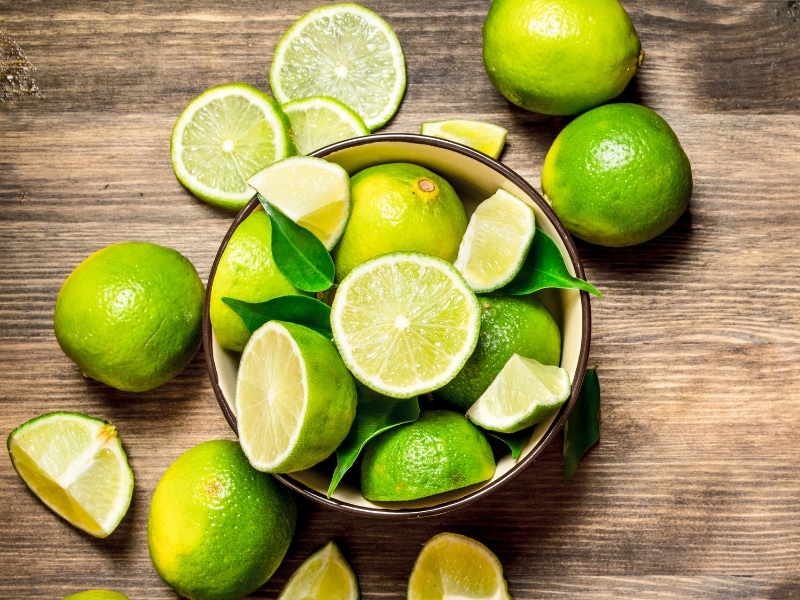From lemons and limes to tangerines and grapefruits, citrus fruits are an incredibly diverse and delicious family of fruits.
And who doesn’t love citrus, right?

Zesty, juicy, and so refreshing, citrus has a special kind of tartness you simply can’t find anywhere else.
Though similar in some respects, they’re not all the same.
Each type of citrus fruit brings something unique to the table with its own appearance, flavor profile, and nutritional content.
I’ll talk about what makes each type of citrus unique, its uses, and its health benefits.
So if you’re curious about citrus, read on.
Let’s dive right into the wonderful world of citrus fruits!
Health Benefits of Citrus Fruits
Citrus fruits are more than just a tasty treat. They’re full of powerful health benefits, as well!
Here are some of them:
- They’re packed with vitamin C and potassium, which can improve immunity, strengthen bones, and keep the skin healthy.
- They’re high in thiamin and folate, aiding energy production and cellular repair and regeneration.
- They contain dietary fiber that can help with digestion and reduce cholesterol levels.
- They’re rich in antioxidants that protect the cells from free radicals and prevent heart disease and cancer.
- They help to reduce inflammation.
- They’re low in calories and sugar.
25 Different Types of Citrus Fruits
Can’t pick a favorite citrus fruit? Let this walkthrough help you decide!

1. Meyer Lemon
Meyer lemons are named after agricultural explorer Frank N. Meyer.
They’re believed to be an accidental cross between a regular lemon and an orange or mandarin.
Their skin is smooth and thin, making them much easier to zest than other lemon varieties.
They’re also less acidic and slightly sweeter, an intriguing blend of sweet and sour.
With their unique flavor profile, Meyer lemons are great for adding pizazz to both sweet and savory dishes.
They’re high in vitamin C, fiber, and antioxidants, as well.

2. Mandarin Orange
Mandarin oranges come from the southeastern region of China.
They’re smaller and sweeter than traditional oranges. Their skin is also thinner, which makes them easier to peel.
Sweet, juicy, and bite-sized, they’re an ideal addition to salads. They’re also sweet enough to be eaten as a snack.
You can also use their juice to sweeten sauces or drinks.
Plus, they’re also high in vitamins & nutrients.
As such, they can aid in digestion, regulate blood pressure levels, and boost immunity and collagen production.

3. Grapefruit
Grapefruit is a subtropical citrus fruit with a fragrant aroma and tart and sweet taste.
A combination of pomelo, citron, and orange, it can range in color from pink to yellow.
Its juicy flesh can be eaten raw, used in salads, or used to make jams and preserves.
Grapefruits are high in vitamin C, which supports the immune system.
They’re also rich in potassium, which helps with nerve and muscle maintenance.

4. Tangerine
Tangerines are a sub-type of the Mandarin orange.
They’re smaller, sweeter, and often seedless, making them excellent for snacking.
Their skin is thin and a lot easier to peel than other oranges, as well.
While they’re great on their own, they can also be used in cooking.
Or, add them to salads and smoothies for extra freshness.
As a bonus, tangerines are also a great source of vitamin C, potassium, and fiber.

5. Pomelo
This next citrus fruit is a native of Southeast Asia.
It looks similar to a grapefruit but is usually larger.
Its skin has a thick, leathery texture. The flesh can range in hue and sweetness depending on the variety.
Pomelos are very versatile. They can be enjoyed as-is as a snack, or used in salads.
Their juice also makes a great addition to drinks and sauces.
They’re also high in essential nutrients like vitamin C and potassium.
These nutrients help strengthen the immune system and reduce inflammation.

6. Key Lime
Key limes have yellow-greenish flesh and an oval shape.
They’re also smaller and contain more seeds than regular limes.
They’re slightly tart, acidic, and sweet. This means they’re very versatile.
They can make coconut-lime bars, fish ceviche marinades, cocktails, and so much more.
However, they’re most popularly used to make the classic Key lime pie.
This dessert is so iconic, there’s even an actual Key Lime Pie Day celebrated in late July!

7. Citron Lemon
Citron lemons have a distinct aroma and flavor compared to other types of lemons.
Unlike other varieties, these fruits have thick, bumpy skin and are larger.
The inner pulp is juicy with an intense aromatic smell and an acidic taste.
Citrons can be used in many culinary ways, from making preserves and marmalades to adding flavor to sauces.
They can also be blended into smoothies or teas for a zesty and refreshing treat.

8. Calamondin/Calamansi
Calamansi is a small, round citrus fruit native to the Philippines.
Just like lemons, calamansi is too sour to be snacked on.
Instead, its juice is often mixed with fish or soy sauce, creating a salty-sour condiment used to flavor various Filipino dishes.
You can also use the juice in cocktails for added zing or in marinades for fish dishes.
Or, mix calamansi juice with water and honey to make a refreshing beverage.
Calamansi has many health benefits, too, such as aiding digestion, providing antioxidants, and boosting immunity.
It also helps with skin care, relieving stress, and reducing bad cholesterol.

9. Blood Orange
Blood oranges offer a unique flavor and look compared to traditional oranges.
They get their name and color from anthocyanins, a type of pigment commonly found in berries.
Due to their dark red hue, they’re also often called ‘ruby oranges.’
Blood oranges are sweet with strong berry notes, setting them apart from other citrus fruits.
Not only do they taste amazing, but they’re also high in vitamin C, fiber, and potassium.
Many people don’t get enough of these 3 essential nutrients in their diet.
It’s for this reason that blood oranges are extra popular among health nuts.

10. Kumquat
Kumquats are small in size but pack a powerful flavor punch!
With their slightly tangy, sweet flavor and edible skin, they can be enjoyed raw and on their own.
They make great marmalades, jams, and preserves, as well.
And when used in savory dishes, their bright, tangy taste helps balance out the richer flavors around them.

11. Navel Orange
This variety of orange has several distinguishing characteristics, such as a slightly rough texture, seedless flesh, and a navel-like top.
Navel oranges are also known for being one of the sweetest types of oranges, with hints of sugar on their rinds.
They’re high in vitamin C and provide significant amounts of dietary fiber when consumed.
They make a great snack or kitchen ingredient in smoothies, salads and other recipes alike.

12. Valencias
Valencia oranges are one of the tastiest, juiciest fruits on the planet.
They’re a type of Spanish citrus that originate from the Valencia region in Spain, hence their name.
They’re incredibly sweet and easy to peel, making them perfect for squeezing or juicing.
They become very juicy when they mature in the springtime, which makes them great for snacking.
These succulent oranges are also nutrient-rich and filled with vitamins A and C.

13. Ugli Fruit
Ugli fruit is an exotic citrus fruit native to Jamaica. It’s sometimes called the “ugly orange” due to its unusual shape.
Its rind is very thick, rough, and wrinkly. It can vary in color from almost green to yellow-orange.
Beneath the harsh exterior, however, lies juicy pulp that can taste sweet or tart depending on its ripeness.
Used both fresh and dried, ugli fruit offers an exciting flavor twist in desserts and smoothies.

14. Orangelo
Orangelo is an exciting new citrus that’s recently hit the market.
It combines the sweet and tangy tastes of both oranges and grapefruits. Its flavor is described as gentle yet flavorful.
That said, this citrus hybrid is the perfect snack!
It’s also low in calories, contains about 15 essential vitamins and minerals, and is high in dietary fiber.
It helps boost the immune system, improve metabolic function, reduce inflammation, and combat free radicals.

15. Kaffir Lime
Kaffir limes are a type of citrus fruit found in Southeast Asia and India.
It’s mainly characterized by its fragrant rind and oily flesh.
While not as acidic as other common limes, the intense aroma of kaffir limes makes them popular in the culinary world.
Kaffir lime juice makes a great addition to many dishes like curries, soups, and stir-fries.
Ground-up leaves can also be used to flavor drinks and desserts or steeped into tea for medicinal treatments.

16. Yuzu
Yuzu is an Asian citrus belonging to the same family as mandarins and lemons.
It has a tart yet slightly sweet flavor, with hints of grapefruit or mandarin orange.
While its sourness can be off-putting for some, many can’t resist its heavenly aroma.
Yuzu juice is used to add flavor to fish dishes and dressings.
High in vitamin C and antioxidants, yuzu is also used in beauty products such as moisturizers and face masks.

17. Buddha’s Hand
Buddha’s Hand is a special kind of citron native to Northeast India, Asia and Japan.
Its unusual shape with long, curved fingers makes it incredibly eye-catching.
It has a highly fragrant zest and a slightly sweet pith.
Thanks to its aroma, Buddha’s Hand is often used as decoration.
It can also be grated and added to certain dishes to give it a unique flavor.

18. Clementine
Clementines, a type of Mandarin orange, are low in acidity and usually seedless.
They bear a strong resemblance to tangerines, but they have thin skin that peels easily.
Known for their sweet flavor and juicy flesh, they make an excellent snack as-is.
Clementine peel can also be candied or used to make preserves!

19. Tangelo
A hybrid fruit, a tangelo is an interesting cross between a tangerine and a pomelo.
Tangelos are juicy and bursting with flavor, making them ideal for use in salads or smoothies.
Their peel is thicker than an orange, but they still remain easy to peel and seedless, making them ideal for snacking.
They can also be used as a topping for desserts or breakfast cereals.
Because they’re slightly sour, they also work well in recipes that require tartness, such as salsas and marmalades.
Check out these tangelo recipes for more.

20. Limes
Limes are more than just decorative garnishes for your drink.
They’re an incredibly versatile fruit, boasting an intense flavor that can transform a dish into something extraordinary.
Whether it’s a squirt of lime in a soup, or in seasonings and marinades, limes add brightness to any dish.
21. Finger Limes
This citrus fruit is native to Australia and grows on shrubs or small trees up to 10 ft tall.

These tiny, elongated beauties are a cross between a lemon and a lime.
They have a delicious, tart flavor that can add dimension to both savory & sweet dishes alike.
Plus, they’re also rich in vitamins A, C, B1-3, Iron, Magnesium, Phosphorus, and Potassium.

22. Persian Limes
Originating from the Middle East, Persian limes are juicier and more fragrant than other varieties.
They’re best known for their use in Mediterranean cuisine, often as a condiment due to their tartness.
Their naturally sweet-sour flavor also makes them a popular ingredient in many cocktails.

23. Bergamot Orange
Bergamot oranges are special citrus fruits growing primarily in the Calabria region of southern Italy.
The refreshing aroma of Bergamot oil makes it a key ingredient in perfumes in fragrances.
However, it is also widely used to flavor beverages.
For instance, its juice is often added to Earl Grey teas and Italian lemon liqueur.

24. Bitter Orange
Bitter orange, also known as Seville orange or sour orange, is an intense treat for the tastebuds.
They have a bright color, thin peel, large & juicy segments, and an aroma like no other.
Their flavor is sweet, with slightly bitter undertones.
With such a distinct flavor, bitter orange is a popular ingredient in many drinks and liqueurs.

25. Kinnow
Kinnow is a hybrid variety between two citrus cultivators, known as “King” and “Willow Leaf.”
The result is a sweet-sour citrus with a deep orange hue.
It has small to medium-sized rough peels and juicy segments filled with large seeds.
Kinnow is widely consumed as fresh, squeezed juice or processed products like jams and juices.
It’s rich in numerous vitamins, minerals, and antioxidants.
Some of its health benefits include improved digestion, eye health, bone strength, and immunity building.











